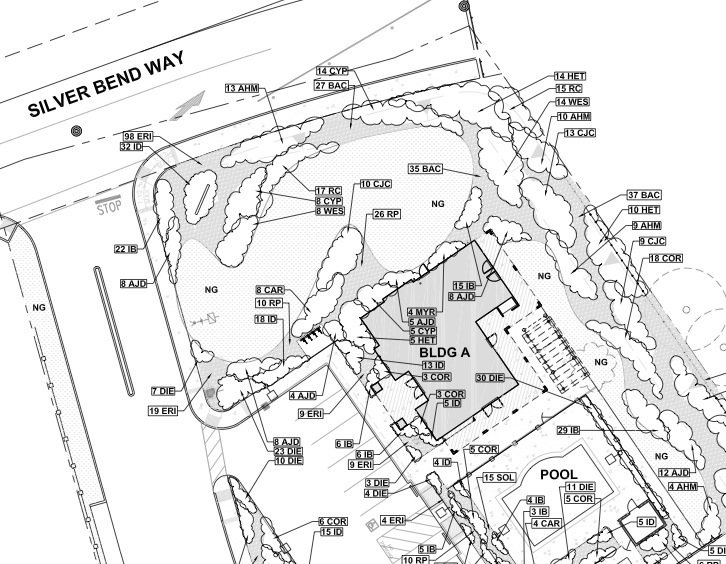Forum Replies Created
-
AuthorPosts
-
June 27, 2013 at 7:17 pm #154647
 Paul DeeringParticipant
Paul DeeringParticipantBrian, I’ve been using the “cloud” function in AutoCAD for years to outline a plant grouping, and then taking the area that AutoCAD will give you for that cloud, divide by the square of the plant spacing for that particular type of plant and label the “cloud” with the plant abbreviation and quantity. I started this in frustration with groundcover spacing that is not definitive enough about actual quantities (how far from edge to start etc.). This method also means you call for enough plants – I think people get tired of clicking in every plant individually which I suspect is the cause of those landscapes with plants sprinkled around sparsely.
October 12, 2012 at 8:05 pm #156279 Paul DeeringParticipant
Paul DeeringParticipantI used to run Windows Vista on an iMac in a partition (for AutoCAD), and I tried Fusion and it worked for me for a while, but not crisply which is important when you are on a deadline and need to just work hard. When I needed to up-grade my iMac, I bought another iMac and just put the two side-by-side. I use the old iMac solely as a PC now (with just Bootcamp so everything runs just like it is a PC). Both computers work on files stored on a Mac Mini so that the other person in our office can get at them just as easily. All of this is on a wireless network and Apple’s wireless is just fast enough to keep me happy while opening and saving during AutoCAD work. Since the old iMac doesn’t store the files, hard drive space is not a problem, and the 4GB random memory works fine in AutoCAD since it is totally dedicated to Windows because it is running via Bootcamp.
September 19, 2009 at 1:39 am #173058 Paul DeeringParticipant
Paul DeeringParticipantI’ll pass along that I’ve been with Leatzow for maybe 15 years now and I’ve found them responsive by US mail, phone and email, and having been through two lawsuits with them, I have to say they’ve been great. I’ve been in business for over 30 years in California, so two suits is probably not bad, though at the time any lawsuit is horrible. Lawsuits put you at a disadvantage in a world that you are not familiar with and cannot control even though you have a crystal clear understanding of the subject being litigated.
The other bit of information that I’ll pass along about the whole world of litigation is that you really need an attorney that can put the fear of god in the minds of the opposing attorneys. The opposing attorney needs to know that your attorney will make their life miserable (remember that the plaintiff is probably working on speculation, so getting tossed out is a possibility). Your goal is to get dismissed from the case as early as possible or to get though arbitration as early as possible. Time is what kills those named in suits – it uses up your deductible, then takes more from your insurance company. The plaintiff’s attorney has no incentive to speed things along. In both of my cases, Leatzow agreed to use my attorney to represent me. I think this was critical to controlling my costs.
In California most municipalities that you work for require a million dollars of coverage – for park projects for example. You’ll often be asked to provide two million, but I’ve been successful in arguing that this amount was probably designed for architects who’s responsibility usually covers much more expensive building projects. Just ask about this requirement and tell them that you can provide it, but that you’ll have to increase your coverage and apply the extra cost to your fee.
August 8, 2009 at 3:20 pm #173448 Paul DeeringParticipant
Paul DeeringParticipantOn a related subject, I’ll pass along that there is a straightforward way to move AutoCAD files to Photoshop. You probabably know that AutoCAD doesn’t provide a “save as” or “export” to Photoshop (probably intentionally because they want you to use their own products for rendering). An inexpensive program “Bluebeam” acts as a printer from AutoCAD and produces Photoshop files (you set the resolution). It does so reliably so that you can “print” different layers of line work from your AutoCAD drawing making coloring in Photoshop easier.
August 1, 2009 at 6:01 am #174424 Paul DeeringParticipant
Paul DeeringParticipantI don’t think BIM will be of much use in landscape architecture until it is integral to civil engineering and architecture both. In our landscape architectural work, there is a constant back-and-forth between what we do, the civil’s work and the architect’s work. I’ve been asking civil engineers for a couple of years now about BIM and the reply is always “that’s for buildings”. Keep an eye on civil engineers if you want to know when landscape architects will need to use BIM.
July 14, 2009 at 6:10 am #173707 Paul DeeringParticipant
Paul DeeringParticipantRoland,
The recession gave my wife and I (partners in our LA business of 30 years) the time to completely re-landscape our house. We removed all shrubs and groundcovers and all pavement except the driveway. This proved to be important because the grading could be done right (50 years of soil build-up and settling in and around the plants could not be corrected in and around the plants). We installed a complete irrigation system w. smart controller, and planted native California plants last Fall. The project cost about $15,000 in materials and a small amount of labor. We did most of the work ourselves. We’re in the 100 degrees of July now, so we’re learning all about the “smart controller”. The experience has been very educational – about the “smart controller” and also about the realities of using natives in a suburban landscape. I’ll attach some recent photos.
Paul & Annalisa Deering – Deering Design, Davis, California
March 26, 2009 at 5:52 am #176721 Paul DeeringParticipant
Paul DeeringParticipant30 years out now – I can tell you that one of my professors in the Urban Design program said that “they looked first at your portfolio, then, if you made that cut, they started looking at the rest.
March 22, 2009 at 3:14 pm #175744 Paul DeeringParticipant
Paul DeeringParticipantGreat idea about a Creative Commons – or an “open source” green rating system. It could be international, free, all electronic (no paper produced or shipped or stored), all volunteer (like linux), and always being improved and up-dated by users (like linux). It would be nice if such an approach could be focused on results rather than document production, new ideas rather than rules and regulations, and promotion of innovation in order to spread good ideas.
This kind of approach should overarch landscape architecture, planning, urban design, civil engineering, architecture. Each discipline could work to improve and up-date the rating system for their specialty – all fitting within the overall environment which is the ultimate goal.
March 15, 2009 at 5:40 pm #175746 Paul DeeringParticipant
Paul DeeringParticipantThe more I’ve read about the SSI approach, the more I wonder who is going to evaluate and score the projects. Absent a performance-based approach, the need for lots of highly trained evaluators (means landscape architects with real experience) will grow along with the success of the program. Check the billing rates of the senior landscape architects in your firm as a start, then ask some of them how much time they’d like to devote to scoring projects for SSI.
I want to be positive here – and I think the solution is performance-based standards, not paperwork documentation of thought-processes. It would be great to discuss different approaches to “proof of concept” in this kind of forum.
An easy starting point is water. This natural resource screams for a performance-based proof. Most commercial projects in California require separate landscape water meters. This began kind of innocuously as a way to charge commercial projects more fairly for sanitary sewer treatment. At first, you could opt to pay for a separate landscape meter and the sewer rate would only be calculated on the basis of the other “domestic” meter. Then, when water conservation came to mean a lot more, cities and counties began requiring this as a matter of course.
Most California water conservation ordinances require some kind of calculations to show that landscape water need not exceed a maximum precipitation rate. The maximums are usually modest – 80% of the local evapotranspiration rate (water needed for pasture grass). So watching the amount of turf can easily reduce water use – as can the intelligent use of plant materials. This could set up a balance between mandatory and voluntary programs – where municipalities require 80% or less, and SSI gives points for less than that.
Both LEED and SSI currently use a “calculated baseline case” from which potable water use reduction is to be calculated. With this method, the landscape architect has to essentially design a “baseline case” – and while some might see this as using conventional spray heads (about 2″ per hour) for shrub and lawn areas, others might say that approach to irrigation is so out of date that achieving a 50% savings from that is no savings at all – that we’d just be designing irrigation the way we currently do, with MP Rotators, low water use plants, minimal lawn and whenever possible native plantings that might only need establishment irrigation. I’d like to use the “percent reduction from ET” approach because there is a scientific basis for the “base” case – that comes from the world of agriculture and is not really debatable within landscape architecture.
The paperwork for this kind of approach to water conservation could consist of an establishment period and an established irrigation schedule as well as a monthly total water use calculation. Both of these calculations would be useful to others besides LEED or SSI evaluators – the schedules for the contractor and the monthly totals for the client to check the landscape contractor’s clock management. I’d like to see an attempt by LEED and SSI to keep paperwork requirements for documentation limited to products that are actually useful to the client, construction contractor, maintenance contractor, or regulatory agencies who monitor resource use.
I’d be interested in anyone’s experiences with other resources that could be conserved with a similar “performance-based” approach.
February 21, 2009 at 6:17 am #176187 Paul DeeringParticipant
Paul DeeringParticipantBrian, Learning new tricks is a positive activity during this worldwide recession. I’ve re-done my standard construction details in SketchUp – its free and very fun.
On the Green front, I’m looking for support in making SSI a new trick to learn rather than another list of paperwork to manage in my projects. I like what I’ve read below about performance-based standards – water conservation is an easy one – don’t make me provide spreadsheets of computations, phony “baseline total water applied” calculations or narratives of landscaping and water conservation strategies, just give me a target percentage of local ET and I’ll provide an irrigation schedule and plant palette that meets that percentage.
When I read the new report, one of the questions I had was “who’s going to review all of this paperwork?” The review work involved is just like a studio crit or design competition judging – not something that can be done with a Scantron machine. Are we really going to set up a system where groups of professionals are paid to judge submittals? There will be a lot of money involved in getting certified if SSI is a success, not to mention the subjective nature of the decisions (there’ll be an appeals procedure too I suppose).
I’m genuinely looking for an avenue to help SSI become positive rather than paperwork.
-
AuthorPosts



